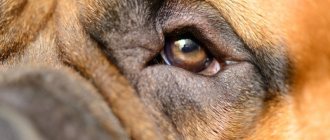Content
1. The main causes of chlamydia disease 2. General clinical picture of the disease 3. Typical symptoms of the disease 4. Accurate testing of a dog for chlamydia 5. Organization and procedure for treatment 6. Preventive measures 7. Is chlamydia dangerous for humans 8. Video: 9. Let's summarize
Every dog owner wants their pet to remain cheerful, mobile and active.
The viral disease Chlamydia can harm your pet's health. And even threaten life itself.
Chlamydia disease is dangerous for all individuals. At high risk are:
- puppies
- pregnant individuals
- older dogs
In the absence of proper control and prevention, adults can become ill. The disease usually strikes the first blow in the animal’s genitourinary system; during pregnancy, the birth of non-viable offspring or abortion is possible.
The owner’s task is to ensure control of the pet’s health. At the slightest suspicion, do not self-medicate, but contact a veterinarian. It is important to regularly carry out all necessary inspection activities. Proper organization of diet, walks, and rest is another requirement.
Chlamydia in dogs
Chlamydia in dogs is an infectious disease caused by chlamydia abortus and psittacs and accompanied by abortions, conjunctivitis, enteritis, pneumonia, arthritis, urethritis, orchitis, and encephalitis.
Chlamydia abortus infection occurs through sexual contact and in utero. The alimentary route of infection is observed in dogs, which, especially in rural areas, eat meat, aborted fetuses, stillborn calves, and membranes in farms where farm animals are unaffected by chlamydia. With this form in dogs, there is mainly damage to the reproductive and urinary systems, very rarely, but there is also a generalized form of infection.
When infected with chlamydia psittacosis , airborne and airborne dust routes of infection are present (by sniffing droppings and birds that have died from psittacosis). In cities, the source of this type of chlamydia is birds (mainly pigeons), which are the main reservoir of chlamydia. City dogs have a greater chance of catching this type of chlamydia on city streets and parks while walking. Damage occurs to the respiratory system, eyes, liver, and nervous system, and chlamydial myocarditis develops. In 30% of dogs, symptoms of hepatosplenomegaly are recorded, and gastrointestinal tract damage occurs (vomiting, diarrhea).
Considering that chlamydia is a zooanthroponosis , dogs with chlamydia are a potential source of infection for people , especially in large cities where dogs are kept in apartments. For people, the consequences of contracting chlamydia can be very serious: abortion, infertility, chronic diseases of the genital area, arthritis, conjunctivitis, etc. Taking this into account, outreach work should be carried out with pet owners, recommendations should be given on preventive vaccinations of dogs against chlamydia, and even if If a disease occurs, adherence to the strictest personal hygiene measures, thorough comprehensive treatment of the sick dog, conducting serological tests of the owners and all people in contact with the sick dog.
Dogs contract chlamydia mostly asymptomatically. Clinically, chlamydia in dogs manifests itself when the body’s resistance weakens, as well as the addition of some secondary infection.
by clinical polymorphism ; the disease can occur in the form of rhinitis, bronchopneumonia, anorexia, conjunctivitis, keratitis, blepharitis, and enteritis. When chlamydia affects the middle ear, purulent otitis , leading the dog to deafness. When joints are affected, chlamydia arthritis develops . Sometimes the disease begins with a sharp increase in body temperature to 40-41°C. As a result of the infection, dogs may experience complications: polyneuritis, paresis of the limbs, meningoencephalitis, iridocyclitis, myocarditis.
With the genital form, dogs experience infertility, abortions in the second half of pregnancy, and the birth of non-viable, diseased offspring. Bitches have endometritis and vaginitis, males have prostatitis and purulent balanoposthitis, urethritis, pyelonephritis, cystitis. The genital form of chlamydia is accompanied by the discharge of abundant whitish inflammatory exudate from the external genitalia; When examining the vulva and vagina, swelling and hyperemia are noted; inflammation in the genital area causes itching in dogs.
newborn puppies develop symptoms of conjunctivitis, cough , and sometimes develop bronchopneumonia and cystitis . With severe damage, puppies die at the age of 20-30 days.
The chronic form of chlamydia in adult dogs is characterized by decreased appetite, sluggish conjunctivitis, periodic catarrh of the upper respiratory tract, abortion, and intermittent claudication at normal body temperature.
The diagnosis of chlamydia is made on the basis of the clinical picture and laboratory testing for chlamydia (serological tests using the RSK, RDSC, RIF, PIF, ELISA, PCR methods).
Treatment. It must be comprehensive, taking into account the clinical form of chlamydia, the severity of the disease and the presence of complications. Treatment should consist of etiotropic therapy, immunocorrection, intensive vitamin therapy, biocorrection, and at the same time local treatment must be applied.
Etiotropic therapy - carried out with the aim of eliminating chlamydia from the body of a sick dog; for this purpose, a dog with chlamydia is treated with macrolides (clarithromycin, roxithromycin, azithromycin), tetracycline drugs (ichtralletenDN forte, doxycycline, metacycline 3), fluoroquinolones (ciprofloxacin, tsifran, ciprovet). Today, the drug Klacid .
Based on the development cycle of chlamydia during etiotropic treatment, there are two approaches to its implementation.
First: a continuous course of antibiotic treatment is carried out, during which it is possible to change the antibiotic within 21-28 days.
Second: three courses of antibiotic treatment for 7-10 days with breaks of 7-10 days (the so-called pulse therapy is carried out with the aim that the intact extracellular elementary bodies remaining after the first course of antibiotic therapy in the intercellular spaces undergo phagocytosis during a break in treatment. During After a break in the phagocytes, microcolonies of parasites are formed, which will die after the second and third courses of etiotropic therapy.
An indispensable condition for successful treatment of chlamydia is the use of immunomodulatory drugs and intensive vitamin therapy. Today, the most effective immunomodulator is cycloferon. From vitamin preparations - Gamavit.
For the purpose of biocorrection (restoration of normal biocenosis), during treatment it is necessary to use Linex, liquid bifidum - and lactobacterin, lactobifid.
Based on the fact that liver function suffers in dogs with chlamydia infection, it is necessary to include in the treatment regimen the use of hepatoprotective drugs (Essentiale Forte), as well as antihistamines (Tavegil, Claritin).
For chlamydial conjunctivitis, blepharitis, keratitis, local treatment is prescribed by placing ointments containing tetracycline, erythromycin, ditetramycin) into the conjunctival sac 1-2 times a day or a 10% solution of sulfapyridazine 2-3 times a day.
For the genital form of chlamydia, instillation of the vagina of bitches is carried out with a 2% solution of boric acid in an amount of 100 ml or lactic acid. Among modern means, you can use HILAC-FORTE (40 drops per 100 ml of water) - exposure time is 10 minutes. For male dogs, octenisept (1:8 dilution) is instilled into the preputial sac, 5-10 ml once a day, the course of treatment is for 7-10 days.
Prevention: proper raising and maintenance of dogs. Before mating, a laboratory test for chlamydia is performed. Annual vaccination of dogs against chlamydia (ChlamyCon).
After completing the course of treatment, after 6-12 weeks it is necessary to conduct a control serological test for chlamydia.
The main causes of chlamydia
Microorganisms that carry chlamydia are very tenacious. They are difficult to destroy and neutralize. Another characteristic difference of the virus is reduced susceptibility to drugs. antibiotics. Bacteria die only after prolonged exposure to high temperatures (above + 40°C). The penetration of chlamydia into the external environment is quite limited. As a rule, this is feces, as well as discharge during an abortion (plus the contaminated aborted fetuses themselves).
Chlamydia can enter a dog's body:
- When eating meat products that have not undergone heat treatment, as well as contaminated feed.
- Sexually, with uncontrolled sexual intercourse of individuals.
- When dogs sniff each other, the virus can be transmitted by airborne droplets from an infected individual to a healthy dog.
- For insect bites.
- Inside the womb of an infected mother.
What is chlamydia in dogs?
An infectious disease provoked by different types of parasites of the Chlamydiae type (abortion and psittacy) causes many clinical manifestations in the animal:
- blepharitis;
- keratoconjunctivitis;
- non-viable litter and abortion;
- urethritis;
- encephalitis;
- arthritis.
Chlamydia is a harmful microorganism that occupies an intermediate position between bacterial and viral infections. Their main feature is the ability to transform into forms resistant to antiviral and antibacterial agents. The causative agents of the disease are resistant to antibiotics.
Moreover, the parasites that cause infectious disease in dogs are sensitive to high temperatures and sudden changes in the acid-base ratio. At a temperature of 41-45 degrees, microbes die.
Carriers of microorganisms are mainly rodents, birds, and stray animals. Chlamydia can reproduce only inside living cells of the affected organism. The infection enters the environment through excrement, secretions of the birth canal, and dead fetuses as a result of miscarriage. Treatment of chlamydia in dogs is a long process and requires an integrated approach.
General clinical picture of the disease
Experts note the existence of two main forms of chlamydia.
The first is Latent. It usually affects animals with a strong immune system. There may be no obvious external signs. Especially at the initial stage of the disease. But the animal is already a carrier of a dangerous virus. Activation of the disease is facilitated by inadequate care, poor living conditions for the animal, unbalanced nutrition, lack of discipline, and lack of control on the part of the owner.
If the disease progresses and actively develops in the body affected by the virus, then externally in the dog it can manifest itself through various diseases, such as rhinitis, arthritis, purulent conjunctivitis.
Definition of disease
Chlamydia is a disease caused by such types of chlamydia as Chlamidofila psittaki and Chiamidophila abortus. The disease progresses from year to year, and today we can already say that there are more pathogens. Moreover, some of them cannot be classified as either viruses or bacteria, since they do not have a position in the general qualifications. The disease is extremely dangerous due to the fact that some of its forms are practically untreatable even with the most powerful antibiotics of the latest generation.
Accurate testing of a dog for chlamydia
To identify the disease at an early stage, it is necessary to conduct a diagnosis. This is the veterinarian's job. The following methods are used for verification:
- External examination of the animal.
- Questioning the dog owner about the dog's behavior over the past few days.
- Collection of biological materials, laboratory analysis.
The veterinarian must take a smear from conjunctivitis, from the genitals, and draw blood.
Research helps identify the disease. The next step is choosing the right antibiotic. It is important to establish a level of drug concentration that will destroy harmful bacteria in the animal’s body.
Forms and symptoms
There are only two types of forms of this disease: asymptomatic and symptomatic. In the asymptomatic form, the dog appears healthy in appearance and does not feel any ailments. But harmful bacteria remain viable, although they are not capable of reproduction.
In the event of certain stresses (for example, weaning puppies from their mother), the infection becomes more active.
But in the symptomatic form the following may appear:
- severe purulent mucous eye and nasal discharge;
- light, abundant discharge from the genitals;
- cumulative worsening malaise, loss of physical activity, response to external irritants;
- slow conjunctivitis;
- recurrent catarrh of the upper respiratory tract, cases of shortness of breath;
- disturbances in heart rhythm;
- change in the animal's actions;
- loss of appetite, refusal to eat.
Organization and procedure for treatment
Treating a dog infected with an infection is a long and complex process. It requires attention, perseverance, strict compliance with the requirements and instructions of the veterinarian. In the process of restoring health, etiotropic and symptomatic therapy is carried out. Additionally, measures are taken to strengthen the immune system.
Typically, antibiotics are prescribed for 3-4 weeks without a break, administered intramuscularly daily.
Another option is pulse therapy (involves 7 days of injections, 7 days off and again 7 days of injections). To restore the body, vitamins, probiotics, and other medications are prescribed; to relieve and remove mucous secretions, ointments and solutions are prescribed.
Repeated tests to detect viruses in the dog’s body are prescribed after 1 – 1.5 months.
Treatment regimen for chlamydia in dogs
Treatment methods for detecting chlamydia are primarily aimed at eliminating the pathogen from the body of the sick animal. One of the main troubles is a complication when contacting antibiotics in the form of dysbiosis. Other negative manifestations are concomitant infections, which complicate the recovery process, and chlamydia resistance to most antibiotic drugs.
Treatment should be carried out in combination with immuno- and biocorrection. Taking vitamins is mandatory. The following drugs are used to treat the disease:
- Macrolides.
- Tetracyclines.
- Fluoroquinolones.
The most promising at present is Klacid, which belongs to the macrolide group. It is distinguished not only by its high antibacterial activity, but also by good tolerability and the least pronounced side effects, in particular dysbacteriosis.
Video: what is chlamydia in dogs, its symptoms and treatment
Diagnostics
The diagnosis is made based on the collected medical history, severe symptoms, and a survey of the pet owner. To accurately establish the clinical picture, a serological test is carried out in the laboratory. Despite the presence of obvious signs, it is impossible to accurately diagnose at home.
Mainly, enzyme immunoassays and polymerase chain reactions are used to make a diagnosis. The laboratory performs analyzes of scrapings and smears taken from mucous membranes.
The disease can occur in both latent and subclinical forms. Symptoms of chlamydia in dogs can vary. Age, body weight, and the presence of previous injuries and diseases play a role in this.
In the subclinical form, the following signs are revealed:
- sluggish conjunctivitis;
- arrhythmia;
- urethritis;
- cystitis;
- temperature rise to 41 degrees;
- light discharge from the genitals;
- insomnia or increased sleepiness;
- lethargy;
- temporary lameness in one of the limbs;
- copious discharge from the eyes and ears;
- bronchitis;
- diarrhea;
- anorexia;
- encephalitis;
- shortness of breath and so on.
Pregnant bitches often lose their babies in the second half of pregnancy. In advanced forms of the disease, bitches are deprived of the opportunity to have offspring.
Puppies born from an infected female often suffer from bronchitis and conjunctivitis or have other physiological abnormalities, and in severe cases of infection they die before reaching a month.
Males suffer from prostatitis and urethritis. Inflammation of the foreskin occurs, and purulent discharge is detected.
Depending on the location of the parasitic cells, certain organs are affected. Chlamydia cells can affect the liver, joints, or middle ear.
If it hurts your dog to step on its paws and it tries to lie down more, most likely the pet is affected by arthritis, and an urgent study is needed to identify the cause of the disease.
The same manipulations must be performed for otitis, conjunctivitis and disorders of other organs, for example, the gastrointestinal tract. Even a disturbance in the functioning of the gastric microflora requires treatment, otherwise it can lead to serious consequences, not to mention chlamydia in dogs.
If symptoms of the disease are detected, you must contact the clinic to collect anamnesis. The detected symptoms may indicate other diseases.
But often other diseases coexist with the presence of chlamydia in the body, and delay in treatment can lead to irreversible consequences. The presence of conjunctivitis can lead to complete blindness, and the infected liver may not be able to withstand the stress of treatment or localization of parasites in it.
When the medical history is collected and suspicions are confirmed, treatment must be started immediately. Self-medication is strictly prohibited, because chlamydial cells are difficult to remove even with strong drugs. In addition, the disease can be transmitted to humans.
Treatment proceeds as follows:
- drugs of the tetracycline group (Metacycline) are prescribed;
- macrolides (Azithromycin) are prescribed;
- fluoroquinolones are prescribed, for example, Cifran;
- for conjunctivitis, treat the eyes with special drops and ointments;
- in females, the genitals are washed with lactic or boric acid;
- In males, the preputial sac is douched.
Treatment usually lasts about four weeks. A course of treatment is possible. First, the drug is given to the animal for 10 days, then a break is taken for the same period, and repeated several times until the end of the course. This way the parasitic cells weaken and die much faster.
In addition to the direct treatment of this disease, the animal is prescribed drugs that support intestinal microflora (Linex). If this is not done, dysbacteriosis may begin, which will negatively affect the body, weakened by pathology.
Any intervention in the body does not pass without leaving a trace. A dog suffering from the disease may have an allergic reaction to the medications, so it is necessary to give it antihistamines.
To strengthen the body, vitamin complexes (Gamavit) and immunomodulators (Cycloferon) are prescribed.
Diagnosis of the disease
As mentioned above, the symptoms of chlamydia are extremely vague. Therefore, only a doctor can make a diagnosis. To do this, you will need tests, or rather, a serological blood test using the RIF, RDSC, RSK, ELISA, PIF, PCR methods.
If you suspect chlamydia, you need to show your dog to a veterinarian, who will do all the necessary tests.
Important. No other diagnostic methods will give an accurate result.
Treatment Basics
It should only be carried out by an experienced veterinarian, since a lot of factors should be taken into account: the breed of the animal, its physiological condition, the presence or absence of any serious complications. But how to treat this harmful infection? The classic approach to therapy involves the use of three groups of powerful antimicrobial drugs:
- Antibiotics from the macrolide group.
- Tetracycline group.
- Fluoroquinolones.
In veterinary practice, two treatment options are used: continuous use of the selected antibiotic for 28-30 days. Serological studies are constantly carried out, based on the results of which a decision can be made to change the drug. The second approach, as practice shows, is much more effective and easier to tolerate by the body: a course of antibiotics lasting from 7 to 10 days. Afterwards there is a break for the same period. In total, up to three “passes” are made, during which the colonies of parasites in the cells die completely.
It should be noted that in all of the above cases, compensatory therapy aimed at restoring the disturbed intestinal microflora must be used. If this is not done, the dog will suffer from constant intestinal problems caused by severe dysbiosis for the rest of its life. As you can see, treating chlamydia in dogs is certainly not a simple matter. If you notice any of the signs that we described in the article, immediately take your pet to a veterinary clinic!
What signs should alert you immediately? Here is a short list of them:











